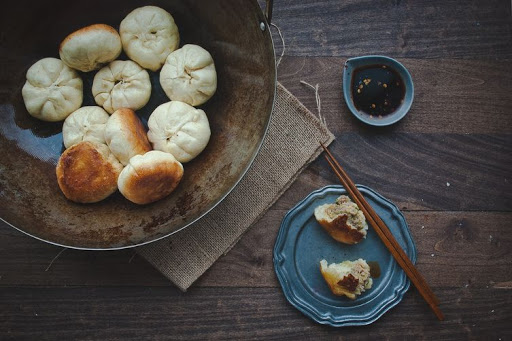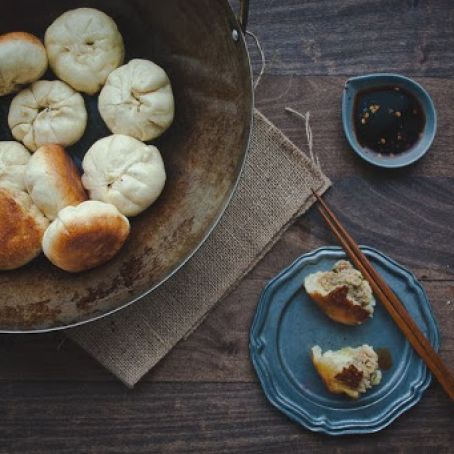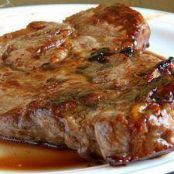Panfried Pork Steamed Buns (Shengjian Bao)
By lorik
Ingredients
- for the dough:
- Makes 18-24 buns
- 2 1/4 teaspoons active dry yeast (1 packet)
- 1 cup milk (any kind will do; I used 2%)
- 1 tablespoon oil
- 3 cups all-purpose flour
- 1/2 teaspoon salt
- 3-4 tablespoons sugar (less if you prefer a more savory dough)
- for the filling:
- 1 pound ground pork
- 1 cup chopped leafy vegetable, like cabbage or bok choy (you can even use Brussels sprouts for extra crunch)
- 1 tablespoon sugar (optional)
- 2 tablespoons soy sauce
- 1 tablespoon sesame oil
- 1 tablespoon shaoxing rice wine (if unavailable, you can use sake or mirin)
- 1 teaspoon grated ginger
- 2 stalks green onion, finely sliced (plus more for topping at the end, optional)
- 2-3 garlic cloves, minced
- 1/4-1/2 teaspoons salt
- 2 tablespoons cornstarch (optional)
Details
Adapted from food52.com
Preparation
Step 1
1. Warm the milk and oil in a pot over low heat until lukewarm but not hot. It should feel comfortable to the touch. Remove from heat and pour into a bowl. Sprinkle the yeast over top the liquid and let sit for 8-10 minutes.
2. Sift together flour, salt, and sugar. Trickle the yeast liquid slowly into the flour, mixing with a spatula or chopsticks as you go. (You can also just alternate between pouring and stirring.) Once all the liquid has been poured in, knead for 10-15 seconds until dough comes together.
3. Turn the dough out onto a floured surface and knead again until smooth, at least 4-5 minutes. Place the dough in a large, greased bowl, cover, and let sit for 1-2 hours, or until doubled in size. I prefer a slower, cooler rise, but you can do whatever you’re used to.
4. When the dough is almost done with its rise, mix together the ingredients for the filling (pork, vegetable, sugar, soy sauce, sesame oil, rice wine, ginger, green onion, garlic, and cornstarch) until well-incorporated. (Note: Regular cabbage or Brussels sprouts are fine to add as is; if using Napa cabbage, you'll need to extract the water first. Sprinkle about a teaspoon of salt over the cabbage and let sit for 10 minutes beforehand, then drain the water that is released and squeeze out any more moisture. This will prevent the bun from getting soggy.)
5. Next, punch down the risen dough. Turn onto a floured surface again and knead for just a few strokes. If the dough is too sticky, add more flour. Pinch or cut off a ping-pong ball size piece of dough and roll into a flat circle of dough about 3 inches in diameter. Place about a tablespoon of the pork mixture into the circle and fold the dough up around the filling, pinching and pleating in a concentric circle until the top is sealed. It doesn’t have to be perfect -- you can always place it seam-side down for a smooth and uniform top. As you can see, I’m far from a pleating expert! For easier pleating, you can try rolling the edges of the dough circle thinner, leaving the center thicker.
6. Place the finished buns on a baking sheet and cover with a damp towel to avoid drying out as you fold the others. You can let the buns proof again at this point if you like, but I find that the second rise is somewhat built into the process -- since pleating the buns takes some time, the buns I prepare first have usually had time to rise again by the time I’ve finished pleating the last ones. On top of that, you’ll likely have to steam these in several batches, so that the buns you prepare last will have proofed by the time the first ones have steamed.
7. When you’re ready to steam the buns, line your basket or steaming tray with a circle of parchment paper. Place the folded buns at least two to three inches apart inside the tray. They will expand significantly, so give them room. I only steamed about three or four per tray.
8. Fill a wok (or pot, or rice cooker, depending on what you’re using) with about an inch or two of water and bring the water to a simmer over medium heat. After the water has begun to simmer, set the basket over the water, covered, and steam for about 15 minutes, or until buns are resilient when touched and filling inside is cooked. Make sure to refill the water between batches, as it will likely boil dry. You may also need to adjust the heat to low as the water boils -- a low simmer is all you need.
9. To fry: Pour a generous amount of oil into a large wok or saucepan -- enough for at least a quarter-inch layer of oil in the bottom. Turn the heat to medium and wait a few minutes to let the oil heat up. Turning the heat down to medium-low or low, place the buns in a single layer in the wok and let sizzle for 2-3 minutes, or until golden brown. If it’s sizzling too violently, turn the heat down or off for a minute or two until it calms down, and keep a close eye on the bottoms of the buns. I like to keep the heat lower because it doesn’t matter if the buns take a bit longer to fry up, but it’s a bummer if they burn! Remove from the pan when browned on the bottom and drain on paper towels. Let cool slightly, then eat while still crisp and warm. Optional: Serve with extra chopped scallions sprinkled over top and dipping sauce on the side. My favorite is a simple sauce made from 1 part soy sauce 1 part chili garlic sauce, but you can use whatever you like best. I sometimes add Chinese black vinegar and a touch of sugar, too.
You'll also love
-
 Apple Cider Donut Cake
4.6/5
(10 Votes)
Apple Cider Donut Cake
4.6/5
(10 Votes)
-
 Beef Barley Soup II
4.6/5
(10 Votes)
Beef Barley Soup II
4.6/5
(10 Votes)
-
 Bacon-Goat Cheese Jalapeno Poppers
4.2/5
(41 Votes)
Bacon-Goat Cheese Jalapeno Poppers
4.2/5
(41 Votes)




Review this recipe